Themed collection Fluorine Chemistry

Reversible hydrocarbon /perfluorocarbon phase-switching of [Ru(bipy)3]2+ driven by supramolecular heteromeric fluorous carboxylate–carboxylic acid H-bond interactions
Self-assembly of a highly fluorous anion leads to quantitative phase transfer of the photo- and electroactive pristine dicationic Ru(bipy)32+ into apolar perfluorinated solvent.
![Graphical abstract: Reversible hydrocarbon/perfluorocarbon phase-switching of [Ru(bipy)3]2+ driven by supramolecular heteromeric fluorous carboxylate–carboxylic acid H-bond interactions](/en/Image/Get?imageInfo.ImageType=GA&imageInfo.ImageIdentifier.ManuscriptID=C1CC12641E&imageInfo.ImageIdentifier.Year=2011)
Chem. Commun., 2011,47, 8250-8252
https://doi.org/10.1039/C1CC12641E
Fluorous tagging of DABCO through halogen bonding: recyclable catalyst for the Morita–Baylis–Hillman reaction
The halogen-bonded adduct between DABCO and two molecules of perfluorooctyl iodide (DABCO·(C8F17I)2) acts as a recyclable fluorous organocatalyst for the Morita–Baylis–Hillman reaction.
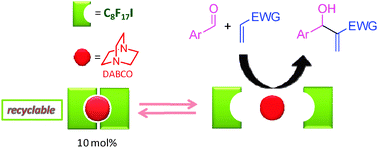
Chem. Commun., 2011,47, 5855-5857
https://doi.org/10.1039/C1CC10869G
Fluorous benzaldehyde -based synthesis of biaryl -substituted oxazabicyclo[3.3.1]nonanes
Fluorous benzaldehyde-based synthesis of biaryl-substituted oxazabicyclo[3.3.1]nonanes is accomplished by a three-step synthesis including a multicomponent reaction (MCR) to form tetrahydroquinoline, followed by cycloaddition with coumarin to form oxazabicycles, and then a Suzuki coupling to introduce the biaryl group. Microwave irradiation and fluorous solid-phase extraction (F-SPE) are employed to speed up reactions and simplify product purification.
![Graphical abstract: Fluorous benzaldehyde-based synthesis of biaryl-substituted oxazabicyclo[3.3.1]nonanes](/en/Image/Get?imageInfo.ImageType=GA&imageInfo.ImageIdentifier.ManuscriptID=C0GC00725K&imageInfo.ImageIdentifier.Year=2011)
Green Chem., 2011,13, 847-849
https://doi.org/10.1039/C0GC00725K
Synthesis of substituted 8-aminoquinolines and phenanthrolines through a Povarov approach
The synthesis of 8-aminoquinolines and 1,10-phenanthrolines with substituents in α of the nitrogen atoms has been performed through an inverse-demanding aza-Diels–Alder in the fluorinated alcohols TFE or HFIP.

Org. Biomol. Chem., 2011,9, 347-350
https://doi.org/10.1039/C0OB00496K
Chemical tailoring of fullerene acceptors: synthesis, structures and electrochemical properties of perfluoroisopropylfullerenes
Linear correlation between the measured E1/2 values and DFT-calculated LUMO energies for ten fullerene(i-C3F7)n compounds with n = 2–6.

Chem. Commun., 2011,47, 875-877
https://doi.org/10.1039/C0CC03247F
Highly diastereoselective synthesis of quaternary α-trifluoromethyl α-amino acids from chiral imines of trifluoropyruvate
An efficient method for highly diastereoselective synthesis of quaternary α-trifluoromethyl α-amino acids and related derivatives was developed via indium-mediated allylation of (R)-phenylglycinol methyl ether based imines of trifluoropyruvate in good yields with high diastereoselectivities.

Chem. Commun., 2010,46, 8029-8031
https://doi.org/10.1039/C0CC02408B
Fluorous diastereomeric mixture synthesis (FDMS) of hydantoin -fused hexahydrochromeno[4,3-b]pyrroles
Fluorous diastereomeric mixture synthesis (FDMS) is introduced and demonstrated in the synthesis of six diastereomers of hydantoin-fused hexahydrochromeno[4,3-b]pyrroles.
![Graphical abstract: Fluorous diastereomeric mixture synthesis (FDMS) of hydantoin-fused hexahydrochromeno[4,3-b]pyrroles](/en/Image/Get?imageInfo.ImageType=GA&imageInfo.ImageIdentifier.ManuscriptID=C0CC01967D&imageInfo.ImageIdentifier.Year=2010)
Chem. Commun., 2010,46, 7578-7580
https://doi.org/10.1039/C0CC01967D
Straightforward synthesis of enantiopure (R)- and (S)-trifluoroalaninol
Enantiopure (R)- and (S)-trifluoroalaninol were conveniently synthesized in a few steps from fluoral hemiacetal or ethyl trifluoropyruvate.
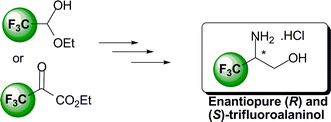
Org. Biomol. Chem., 2010,8, 4540-4542
https://doi.org/10.1039/C0OB00424C
Fluorosugars: synthesis of the 2,3,4-trideoxy-2,3,4-trifluoro hexose analogues of D-glucose and D-altrose and assessment of their erythrocyte transmembrane transport
The 2,3,4-trifluoro-2,3,4-tridehydroxy hexose analogues of D-glucose and D-altrose were prepared and structurally characterised and the novel sugar analogues were explored by 2D-19F-EXSY NMR for their potential to cross erythrocyte (red blood cell) membranes.
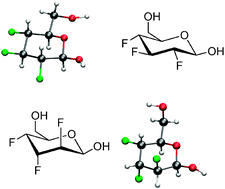
Chem. Commun., 2010,46, 5434-5436
https://doi.org/10.1039/C0CC01128B
1,4-Addition of silicon dienoates to α,β-unsaturated aldehydes catalyzed by in situ-generated silicon Lewis acid
In situ-generated silyl methide species catalyzed the diastereoselective 1,4-addition reaction of silicon dienoates such as 3-bromo-2-silyloxyfuran to α,β-unsaturated aldehydes.
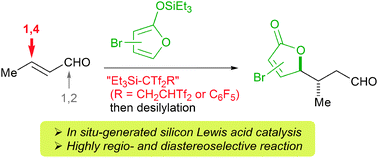
Chem. Commun., 2010,46, 8728-8730
https://doi.org/10.1039/C0CC02438D
Synthesis, characterization, and applications of fluorous resorcin[4]arenes
The fluorous resorcin[4]arene immobilized in a fluorous bulk membrane is capable of transporting tetramethylammonium cation from an aqueous source phase into an aqueous receiving phase.
![Graphical abstract: Synthesis, characterization, and applications of fluorous resorcin[4]arenes](/en/Image/Get?imageInfo.ImageType=GA&imageInfo.ImageIdentifier.ManuscriptID=C0NJ00344A&imageInfo.ImageIdentifier.Year=2010)
New J. Chem., 2010,34, 2732-2734
https://doi.org/10.1039/C0NJ00344A
Convergent 18F radiosynthesis: A new dimension for radiolabelling
Structurally diverse 18F-labelled molecular scaffolds are now accessible in one step combining an 18F-component with two or more additional building blocks. This approach is easy to implement and leads to a series of novel 18F products difficult to access by known methods.
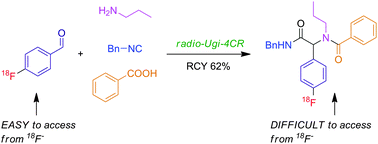
Chem. Sci., 2011,2, 123-131
https://doi.org/10.1039/C0SC00362J
TBAF-Catalysed silver oxide -mediated cross-coupling of functional trimethysilylpyridines: access to arylpyridines and bihetaryl compounds
Silver oxide and catalytic TBAF efficiently promoted the coupling of functional trimethylsilylpyridines with (hetero)aromatic halides.

Org. Biomol. Chem., 2011,9, 1768-1773
https://doi.org/10.1039/C0OB00710B
A recyclable perfluoroalkylated PCP pincer palladium complex
The perfluoroalkylated pincer palladium complex promotes Heck reactions and can be recycled efficiently by fluorous solid-phase extraction without loss in catalytic activity.
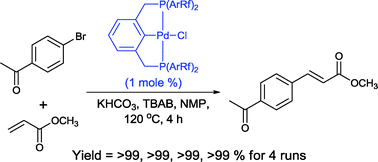
Dalton Trans., 2011,40, 1998-2005
https://doi.org/10.1039/C0DT01004A
Crystal structures of fluorinated aryl biscarbonates and a biscarbamate: a counterpoise between weak intermolecular interactions and molecular symmetry
The directing capability of interactions involving ‘organic’ fluorine in aryl biscarbonates and an aryl biscarbamate as a function of acetylenic spacer units has been analyzed to authenticate the influence of such interactions on the conformational features.

CrystEngComm, 2011,13, 1531-1538
https://doi.org/10.1039/C0CE00537A
Synthesis of gold(I) fluoroalkyl and fluoroalkenyl-substituted phosphine complexes and factors affecting their crystal packing
From the solid state structures of a series of [AuCl(PR2Rf)] complexes (Rf = CF![[double bond, length as m-dash]](https://www.rsc.org/images/entities/char_e001.gif) CF2, CF
CF2, CF![[double bond, length as m-dash]](https://www.rsc.org/images/entities/char_e001.gif) CFH, CCl
CFH, CCl![[double bond, length as m-dash]](https://www.rsc.org/images/entities/char_e001.gif) CF2, C
CF2, C![[triple bond, length as m-dash]](https://www.rsc.org/images/entities/char_e002.gif) CCF3, CF3, i-C3F7, s-C4F9) the relative importance of Au⋯F, hydrogen bonding, fluorous and aurophilic bonding interactions can be assessed.
CCF3, CF3, i-C3F7, s-C4F9) the relative importance of Au⋯F, hydrogen bonding, fluorous and aurophilic bonding interactions can be assessed.
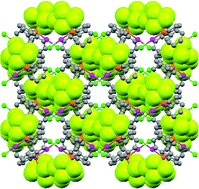
Dalton Trans., 2011,40, 1743-1750
https://doi.org/10.1039/C0DT01014F
Synthesis of difluoroaryldioxoles using BrF3
The general pathway for a new synthesis of difluoroaryldioxoles.

Org. Biomol. Chem., 2011,9, 902-905
https://doi.org/10.1039/C0OB00571A
Enantiospecific synthesis of 2-[18F]fluoro-L-phenylalanine and 2-[18F]fluoro-L-tyrosine by isotopic exchange
2-[18F]Fluoro-L-phenylalanine and 2-[18F]fluoro-L-tyrosine were synthesized by isotopic exchange on corresponding precursors, followed by removal of the formyl group with Rh(PPh3)3Cl and subsequent hydrolysis of the protecting groups.
![Graphical abstract: Enantiospecific synthesis of 2-[18F]fluoro-l-phenylalanine and 2-[18F]fluoro-l-tyrosine by isotopic exchange](/en/Image/Get?imageInfo.ImageType=GA&imageInfo.ImageIdentifier.ManuscriptID=C0OB00440E&imageInfo.ImageIdentifier.Year=2011)
Org. Biomol. Chem., 2011,9, 765-769
https://doi.org/10.1039/C0OB00440E
SN2
Fluorination reactions in ionic liquids : a mechanistic study towards solvent engineering
Ionic liquid is demonstrated to be a tailor-made solvent system for specific chemical reactions.
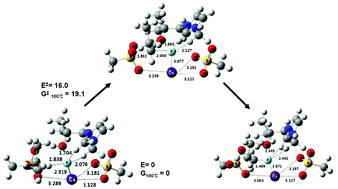
Org. Biomol. Chem., 2011,9, 418-422
https://doi.org/10.1039/C0OB00426J
Synthesis of trifluoromethyl cyclohexyl, cyclohexenyl and aryl compounds via stepwise Robinson annulation
Unprecedented fluorinated cyclohexane and aromatic derivatives were achieved from pentafluoropropiophenone via its tetrafluoroenol silyl ether and a stepwise Robinson annulation.
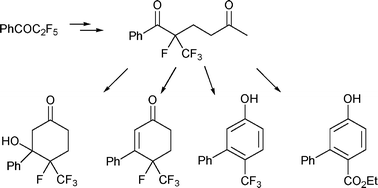
Org. Biomol. Chem., 2011,9, 600-603
https://doi.org/10.1039/C0OB00518E
Chemical reactions inside structured nano-environment: SN2 vs. E2 reactions for the F− + CH3CH2Cl system
A new transition state receptor for selective nucleophilic fluorination has been designed.
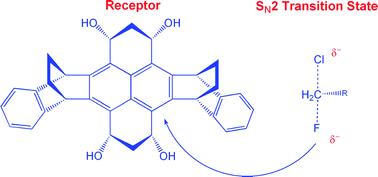
Phys. Chem. Chem. Phys., 2011,13, 779-782
https://doi.org/10.1039/C0CP01182G
Synthesis and structural characterization of group 6 transition metal complexes with terminal fluoromethylidyne (CF) ligands ; a DFT/NBO/NRT comparison of bonding characteristics of terminal NO, CF and CH ligands
Not enough pi to go around! Does the “triple bond” in fluoromethylidyne complexes really have a bond order of three?

Dalton Trans., 2011,40, 47-55
https://doi.org/10.1039/C0DT01006E
Fluoride ion donor properties of group 13 trifluorides (MF3, M = Al , Ga, In, Tl ) and crystal structures of InF3·3SbF5, TlF3·3SbF5 and TlF3·AsF5·2HF
In the crystal structure of InF3·3SbF5 fluorine atoms bridge In and Sb metals (In–Fb–Sb) with very long Sb–Fb bonds, comparable with that in solid SbF5 (Sb–Fb–Sb).

New J. Chem., 2010,34, 2806-2812
https://doi.org/10.1039/C0NJ00514B
Stabilisation of iridium(III) fluoride complexes with NHCs
No examples of fluoride-trans-NHC arrangements have been observed in a series of the new iridium(III) complexes [IrClF2(NHC)(COD)], [IrClF2(CO)2(NHC)] [IrF2L(NHC)(COD)][BF4] and [IrF2L(CO)2(NHC)][BF4].

Dalton Trans., 2010,39, 10781-10789
https://doi.org/10.1039/C0DT00857E
Taking TiF4 complexes to extremes - the first examples with phosphine co-ligands
Structural and spectroscopic characterisation of alkyldiphosphine complexes of TiF4 are reported, but arylphosphines, arsines and thioethers fail to form similar complexes, although [LigandH2][Ti4F18] were minor by-products for some soft-donor ligands.
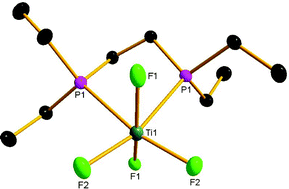
Dalton Trans., 2010,39, 10264-10271
https://doi.org/10.1039/C0DT00747A
Isolation and reactivity of palladium hydrido complexes: intermediates in the hydrodefluorination of pentafluoropyridine
Treatment of trans-[Pd(F)(4-C5NF4)(PiPr3)2] with HBpin yields trans-[Pd(H)(4-C5NF4)(PiPr3)2]. Heating a solution of the latter to 60 °C in the presence of pentafluoropyridine affords 2,3,5,6-tetrafluoropyridine and the C–F activation product trans-[Pd(F)(4-C5NF4)(PiPr3)2].

Dalton Trans., 2010,39, 7513-7520
https://doi.org/10.1039/C0DT00086H
About this collection
The RSC Fluorine Interest group celebrates its tenth anniversary. To commemorate this, the RSC has published a web themed issue on fluorine chemistry across several journals. For an introduction to this web themed issue by the Chair of the RSC Fluorine Chemistry Group and Guest Editor of this issue See OBC Blog.